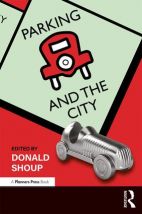Parking and the City

This is a sequel of sorts to The High Cost of Free Parking, which was published in 2005. The introduction to Parking and the City is a condensed update of the earlier book, followed by 51 chapters by a range of authors. The chapters mainly draw on examples of American cities. These are organized into three parts, corresponding to Donald Shoup’s three key recommendations for transforming parking:
1) Remove off-street parking requirements
2) Charge the right prices for on-street parking
3) Create residential parking benefit districts
Paul Barter’s chapter on 14 large metropolitan areas of Asia, in the section on off-street parking requirements, explains that all of the cities studied have requirements for allocating a certain amount of space to parking. This is surprising in dense cities with strong public transport infrastructure, and without historical dependence on cars. The chapter develops a typology of parking policy approaches, according to whether parking is seen as a market good or infrastructure, and whether approaches focus on market responsiveness, area management or particular sites. Barter concludes, “Dense cities with low car usage (most Asian cities) are well suited to supply-neutral or supply-limiting area-management parking policy approaches…and should avoid site-focused approaches and excessively promoting the parking supply” (page 170). He singles out Tokyo as having a relatively flexible parking system that might be replicated elsewhere.
One short chapter, in the section on optimizing prices for on-street parking, analyzes a case from Berkeley, California. As a Christmas gift in 2010, Berkeley’s city council declared that metered spaces would allow free parking – a revenue loss of $20,000–50,000 per day. Shoup argues that this is a misguided kind of gift. In terms of environmental consequences, it worsens traffic congestion and air pollution. It may not even be helpful to the local businesses that would ostensibly be benefitting, as free parking leads to excessive occupancy of parking spaces, and thus less turnover of potential customers. Shoup’s suggestion is that true “parking charity” would involve not free parking, but money from parking charges being handed over to charities.
The last section covers parking benefit districts, which allocate revenue from parking meters to the streets that have such meters. Funded amenities could include landscaping and free wifi. Parking benefit districts have been controversial in Mexico City, where they are known as ecoParq and extend to 26,000 of the city’s parking spaces. This is an ambitious project, aiming to be among the world’s largest paid on-street parking systems, and a model for Latin American cities. Rodrigo García Reséndiz and Andrés Sañudo Gavaldón explain that implementing ecoParq has been challenging because many residents view parking meters as fundamentally unfair, and a formal system threatens the livelihoods of the franeleros (red flannel wavers) who informally manage parking. However, García Reséndiz and Sañudo Gavaldón write, “The quality of life and public space has improved in the ecoParq neighborhoods. The program demonstrates that the overcrowded curb parking was not due to a lack of supply but rather to a lack of efficient management” (page 466).
Parking may not be the most glamorous of topics. But the chapters in Parking and the City suggest that careful management of parking can have substantial effects on a city’s safety, sprawl, navigability, air quality, and revenue for public improvements.
Further reading:
Inci, Eren, Jos van Ommeren and Martijn Kobus (2015), “The external cruising costs of parking”, Tinbergen Institute discussion paper, available at https://papers.tinbergen.nl/15117.pdf.
Knoflacher, Hermann (2006), “A new way to organize parking: the key to a successful sustainable transport system for the future”, Environment and Urbanization Vol 18, No 2, pages 387–400, available at https://journals.sagepub.com/doi/pdf/10.1177/0956247806069621.
Newman, Peter (1996), “Reducing automobile dependence”, Environment and Urbanization Vol 8, No 1, pages 67–92, available at https://journals.sagepub.com/doi/pdf/10.1177/095624789600800112.
Book note prepared by Christine Ro
Search the Book notes database
Our Book notes database contains details and summaries of all the publications included in Book notes since 1993 - with details on how to obtain/download.
Use the search form above, or visit the Book notes landing page for more options and latest content.
For a searchable database for papers in Environment and Urbanization, go to http://eau.sagepub.com/

